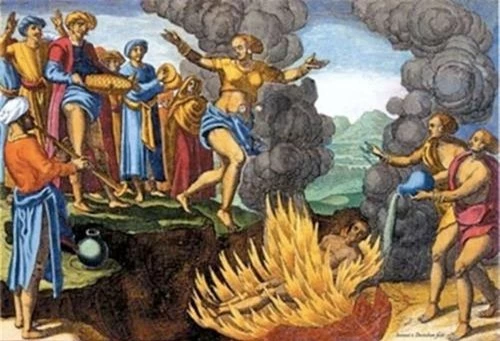10. Geisha
Geisha is a famous traditional Japanese entertainment art form. The word geisha is also used to refer to girls working in this field. They are people who have both singing and dancing talents and the ability to talk and entertain guests.
There are many misunderstandings, especially outside of Japan, about the nature of the geisha profession. Geisha is a healthy, high-class form of cultural talent performance, absolutely not a cheap, vulgar, and prostitution act.

During its heyday, Japan had many geishas. For example, in the 1900s, the number of geisa reached 25,000 people. In the early 1930s, the number was 80,000 people. Most geisha operate in Kyoto, the ancient capital of Japan. Today, the number has decreased significantly. Currently, there are only about 10,000 geisha left in Japan, of which about 100 work in Tokyo.
Real geishas are also increasingly rare. Today’s modern geishas do not have to enter geisha houses from a young age and are no longer sold here due to poverty. Instead, they volunteered to do this work.
However, geisha still have to follow the same training rules as before. Young girls who want to become geisha must learn all the traditional Japanese arts, from dancing, singing, music to painting as well as many other skills.
9. Eunuchs
In ancient Chinese history, eunuchs appeared during the Western Zhou period. There are many other words to refer to eunuchs, for example, eunuch, cong public, internal city, Trung man, internal mandarin…
By the middle of the Ming Dynasty, the power of eunuchs began to be consolidated as they were used more. Because they had the right to act as messengers, oversee the army, mandarins, and people, many eunuchs abused their power. By the end of the Ming Dynasty, the number of eunuchs reached 70,000 people.
Not only China, eunuchs also appear in many other cultures, especially in ancient Eastern societies, with similar “functions”.
In addition, castration of a boy before puberty appears in some cultures as a way to maintain pitch, clarity and sound, creating a special voice so that the child can later sing soprano. .
8. Marry a concubine

Men with high social status or wealth often took many concubines, also known as concubines. The status of a concubine is always lower than that of the first wife, also known as the main wife. Therefore, their children are born with a lower status than their brothers.
7. Challenge to a duel
Becoming popular in Western countries from the 15th to the 20th century, dueling was a form of competition using deadly weapons among the nobility, especially in France. From the 15th to 18th centuries, gladiators often used swords. But from the 18th century onwards, swords were replaced by guns, weapons that only the nobility could own.

After one side challenges, a battle is held to resolve disagreements, personal conflicts, or restore honor. Gladiators have the right to send representatives to compete if they wish.
In a duel, gladiators often do not put the goal of killing their opponent first. Instead, they proved that they were willing to risk their lives to wash away their humiliation and restore their personal honor…
6. Suicide by seppuku
Seppuku, also known as Hara-Kiri, is an ancient ritual of Japanese samurai. This is an important part of bushido culture but is now abolished.

According to this ritual, a samurai would commit seppuku when he “fell” or when his master died to avoid falling into enemy hands, being humiliated, or to show his leader’s absolute loyalty. .
However, samurai could also be ordered by lords or monarchs in feudal Japan to disembowel themselves. Later, disgraced or guilty samurai were allowed to commit seppuku instead of being executed in the usual way.
Because the main purpose of this ritual is to protect honor, those who do not belong to the samurai class will never have to or be ordered to perform this ritual. Female samurai were only allowed to perform this ritual when instructed.
Before disemboweling himself, the samurai had to bathe, wear a white ao dai, and eat his last meal. Then, the instrument used to perform the ritual of seppuku was placed on a samurai plate.
Before committing suicide, the samurai would write a farewell poem. Next, they take off their kimono, take a short sword (wakizashi) or knife (tantō) and stab it into the stomach, cutting a line from left to right.
At the end of the ritual, the samurai could ask someone else to behead him (called a kaishakunin). The kaishakunin would perform a clean slash, called a daki-kubi, that almost completely severed the samurai’s head from the body (leaving only a thin strip of flesh attaching the head to the body).
5. Human sacrifice
This is a ritual of killing people to worship gods or supernatural forces. This practice occurred in many ancient cultures around the world; In particular, sacrificial rituals in different regions have different characteristics.

Victims were turned into human sacrifices, often prisoners, infants or virgins, to please or appease the gods’ anger. Forms of sacrifice include: cremation, beheading or burial alive.
Currently, the practice of using living people as sacrifices is considered a crime and is banned worldwide. However, it is thought that, in the most remote areas of the world, some peoples may still practice similar rituals.
4. Foot binding
This is a custom that was common in feudal China about 1,000 years ago and only applied to young girls. Appearing since the Tang Dynasty, by the 12th century, the custom of foot binding became a “fashion” among the “aristocrats”, especially for women from noble and regal families. However, by the end of the Ming Dynasty, this custom spread throughout society and became the standard of beauty. The smaller a girl’s legs are, the more opportunities she has to choose a prestigious husband.

Therefore, during this period, Chinese girls from 5 to 7 years old had to begin the foot binding ceremony when the bones were still soft and easy to mold. Grandmothers and mothers are often the ones who tie ribbons (usually 3m long, 5cm wide) around the feet of their young daughters. The tighter the bandage is wrapped, the more opportunities a girl has to have beautiful legs in the future.
During the first years of foot binding, girls will suffer extreme pain and be unable to walk. Without help, if they want to move, they have to crawl or crawl. In the following years, the heels began to harden, because during the foot binding process, girls could only move with their heels and absolutely could not walk with their feet or toes. The horrifying beauty process ends when the girls possess perfect feet, usually 7cm – 10cm long.
3. Self-immolation following her husband
Self-immolation (sati) is a custom of Hindus. Accordingly, when the husband dies and is cremated, the widow must jump into the funeral pyre following her husband.

The act of self-immolation following her husband is propagated as based on voluntariness, but in reality, most widows are forced to carry out the macabre custom. It is believed that if widows perform Sati, their family will have good luck for 7 generations. On the contrary, they will face contempt and curses from relatives and the community.
There are many explanations about the origin of this custom. One of them said that sati is intended to prevent the possibility of a wife having an affair or poisoning her husband. Another theory is that sati originated from the legend of a jealous queen. This woman agreed to die with the king to continue to keep her husband in the afterlife. Currently this custom is banned in India.
2. Self-mummification
Sokushinbutsu is the way monks call themselves mummified. These monks, in order to embalm themselves, had to go through a painful process of training.

Before the 3-year mummification process, they will have to adhere to a strict diet. In this way, the fat and part of the flesh of the monks’ bodies, which could rot after death, were almost completely withered.
The next stage of the diet is even more extreme. For the next 3 years, the monks ate only a little bit of tree bark or roots and began drinking a poisonous tea made from the sap of the Urushi tree. This helps lose body fluids quickly. However, more importantly, the poison in the tea will kill all kinds of organisms that can cause the body to rot after death.
Finally, self-mummified monks would lock themselves in a stone tomb no larger than their body and meditate. They only communicate with the outside world through a breathing tube and a bell. Every day, the monk will ring the bell to announce that he is alive. When the bell stops ringing, it means the monk has died and the tomb is sealed.
1. Heavenly burial in Tibet

“Sky Tomb” is a funeral ritual in the Chinese provinces of Tibet, Qinghai, and Mongolia. The majority of Tibetans and Mongolians believe in the Vajrayana school of Buddhism. people about the reincarnation of the soul. According to this school of thought, when a person dies there is no need to protect the body because the corpse is like an empty vessel. So the dead will be chopped into pieces and used as food for the vultures. This is called sky burial. The only place they don’t touch the knife is the head, only leaving the brain exposed because this is where the soul and consciousness reside. This is a scary custom that has existed for a long time in Tibet.
The remaining body parts will be placed in the tower for one year. Men and women will be placed in different places.
Before performing the ritual, monks – called lamas – chant mantras all over the body and sprinkle cedar. The body is then chopped into pieces by either monks or machines. According to Buddhist teachings, using a cutter is easier, which means the soul of the dead can escape faster.
It is difficult to fully understand the Tibetan sky burial process because they strongly oppose people coming to watch just out of curiosity. But they said, the whole body will be food for vultures.
The reason why Tibetans donate dead human flesh to vultures is because they consider these birds to be “divine birds”. They believe that the body being eaten by vultures is a good omen and the dead will quickly be freed. Currently, the Chinese government also bans this custom.





